
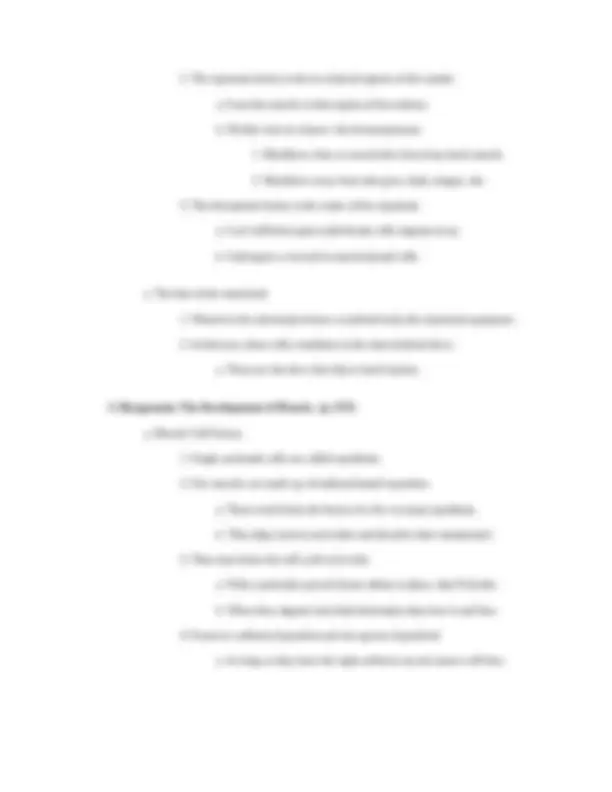
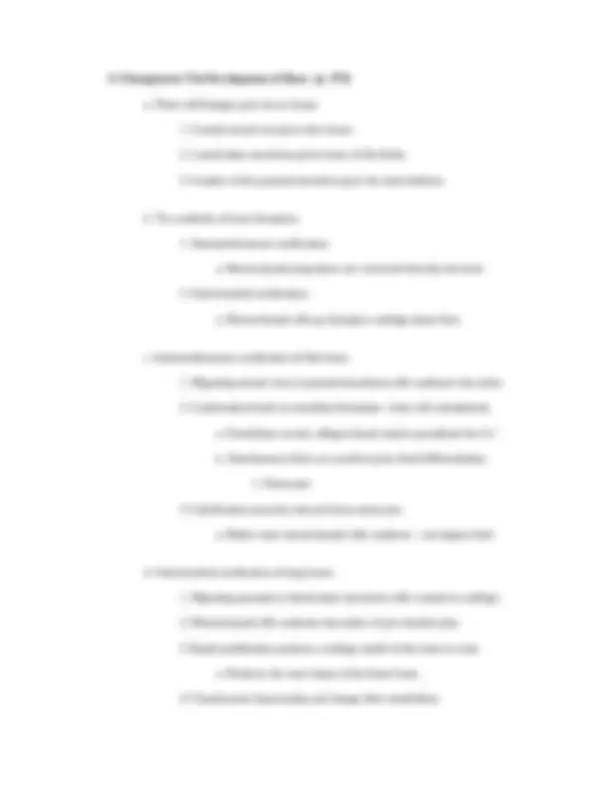
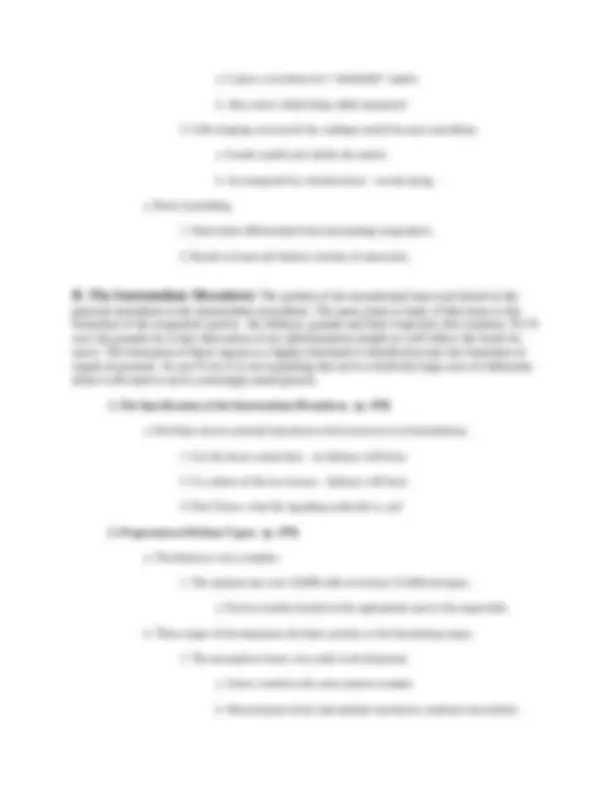
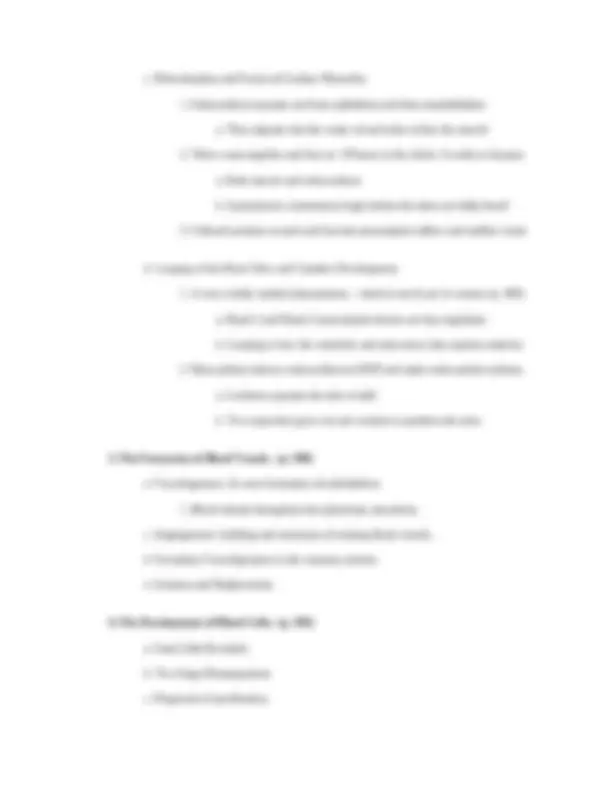
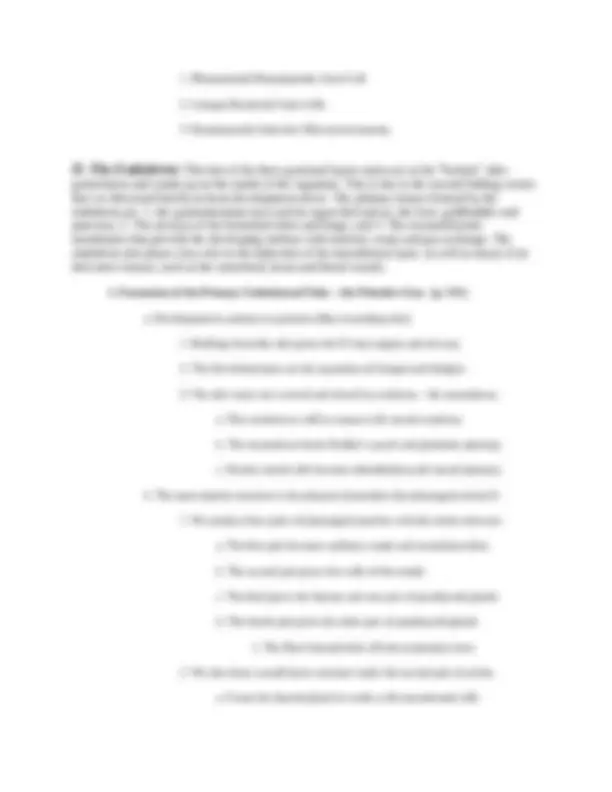
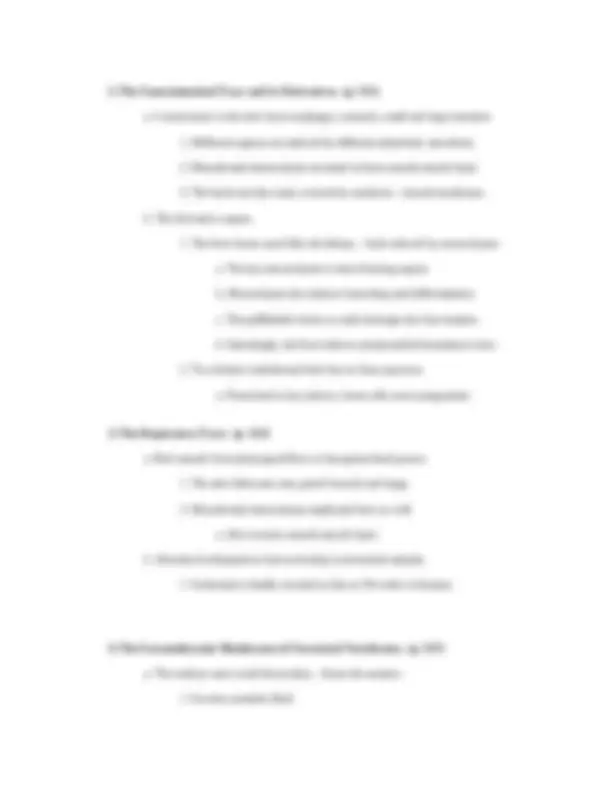
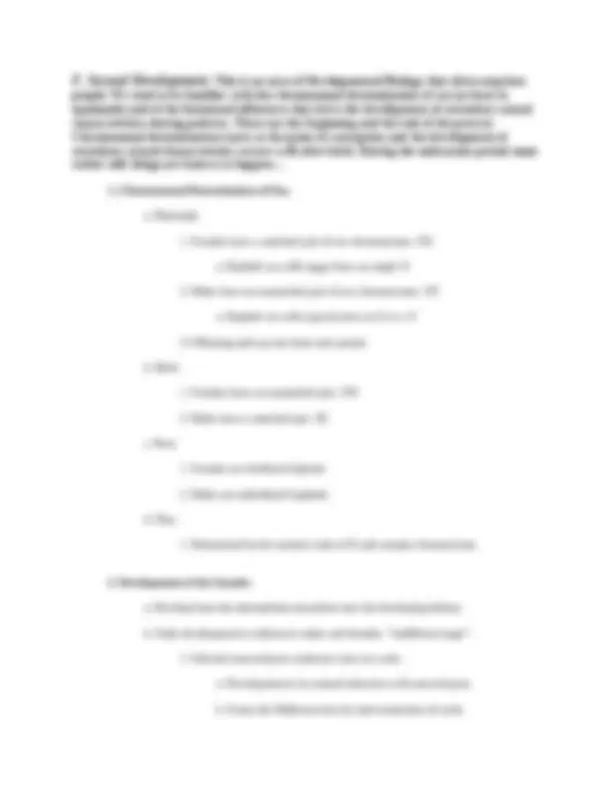
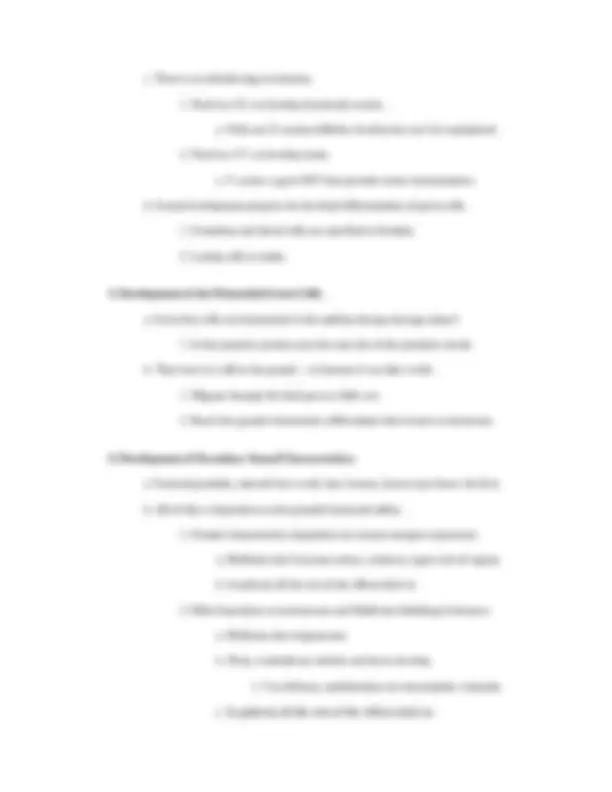


Study with the several resources on Docsity

Earn points by helping other students or get them with a premium plan


Prepare for your exams
Study with the several resources on Docsity

Earn points to download
Earn points by helping other students or get them with a premium plan
Community
Ask the community for help and clear up your study doubts
Discover the best universities in your country according to Docsity users
Free resources
Download our free guides on studying techniques, anxiety management strategies, and thesis advice from Docsity tutors
Material Type: Notes; Class: VERTEBRATE EMBRYOLOGY; Subject: Biological Sciences; University: California State University - Sacramento; Term: Fall 2004;
Typology: Study notes
1 / 14

This page cannot be seen from the preview
Don't miss anything!









1. The Three Subdivisions of the Paraxial Mesoderm. a. The Prechordal Plate Mesoderm. 1. Forms the connective tissue and musculature of the head. b. The Chordamesoderm. 1. Forms the notochord. c. The somitic dorsal mesoderm, or paraxial mesoderm proper. 1. Forms the somites, which give rise to: a. Vertebrae and ribs. b. Dermis of the skin of the back. c. Skeletal muscle of the back and the body walls. d. Skeletal muscle of the limbs.
2. The Formation of the Somites (p. 467). The main mesodermal components that form along the developing neural tube are the somites. We used them in the last section to count out our position along the neural tube but they are much more than place markers. They are the source of the non-cranial axial skeleton and of the musculature of the thorax, abdomen, tongue and limbs. They also provide the cartilage of the spinal cord and ribs, and the dermal layer of the skin of the back. a. The timing and periodicity of somite formation. 1. As the primitive streak moves forward. a. Mesenchymal cells migrate to form the middle layer. b. Simultaneous with start of neural tube formation. c. Presomite mesoderm due to noggin antagonism of BMP 2. As the primitive streak moves backward. a. Henson’s node secretes FGF8 - goes away as node does. b. FGF8 blocks Lunatic Fringe protein expression c. Lunatic Fringe (TF) causes expression of Notch. d. Notch causes expression of Hairy1 in 90 second waves. e. Each wave leads to a new somite forming. b. Somite epithelialization. 1. Mesenchymal to epithelial transformation. c. Specification of the somite along the Anterior-Posterior axis. 1. Somites that form cervical and lumbar vertebrae don’t form ribs. 2. Somites that form thoracic vertebrae also form ribs. 3. Primarily Hox gene dependent like the neural tube. d. Determination of the derivatives of the somite. 1. The sclerotome forms in the ventral-medial portion of the somite. a. Forms the cartilage of the vertebrae and ribs. b. Undergoes a reversal to mesenchymal cells.
4. Osteogenesis: The Development of Bone. (p. 474) a. Three cell lineages give rise to bones. 1. Cranial neural crest gives face bones. 2. Lateral plate mesoderm gives bones of the limbs. 3. Somites of the paraxial mesoderm give the axial skeleton. b. Two methods of bone formation. 1. Intramembraneous ossification. a. Mesenchymal progenitors are converted directly into bone. 2. Endochondral ossification. a. Mesenchymal cells go through a cartilage phase first. c. Intramembraneous ossification of flat bones. 1. Migrating neural crest or paraxial mesoderm cells condense into nodes 2. Condensation leads to osteoblast formation - bone cell commitment. a. Osteoblasts secrete collagen-based matrix specialized for Ca++ b. Attachment to their own product gives final differentiation. 1. Osteocytes 3. Calcification proceeds outward from osteocytes. a. Makes more mesenchymal cells condense – can happen fast! d. Endochondral ossification of long bones. 1. Migrating paraxial or lateral plate mesoderm cells commit to cartilage. 2. Mesenchymal cells condense into nodes of pre-chondrocytes. 3. Rapid proliferation produces cartilage model of the bone to come. a. Produces the exact shape of the future bone. 4. Chondrocytes hypertrophy and change their metabolism.
a. Causes a secretion of a “calcifiable” matrix. b. Also cause a little thing called apoptosis!
1. The Specification of the Intermediate Mesoderm. (p. 478) a. Develops next to paraxial mesoderm which instructs it to form kidneys. 1. Cut the tissue connection – no kidneys will form. 2. Co-culture of the two tissues – kidneys will form 3. Don’t know what the signaling molecule is, yet! 2. Progression of Kidney Types. (p. 479) a. The kidney is very complex. 1. The nephron has over 10,000 cells of at least 12 different types. a. Each is exactly located to the appropriate spot or the organ fails. b. Three stages of development, the latter persists as the functioning organ. 1. The pronephros forms very early in development a. Arises ventral to the most anterior somites b. Mesenchyme of the intermediate mesoderm condense into tubules
1. The Structural Divide in the Lateral Plate. a. The Somatopleure. b. The Splanchnopleure. 2. The Development of the Heart. (p. 492) a. A Little Anatomy Review. 1. The heart is a muscular hollow ball about the size of your fist. 2. Four chambers contract synchronously – two atria, two ventricles. a. The right and left atrium contract together to fill ventricles. b. The right and left ventricles contract together to send blood out. 1. The right side fills the lungs, the left the rest of the body. 3. The vena cava flows into the right atrium 4. The pulmonary artery out of the right ventricle, the aorta out of the left. 5. Valves form between atria and ventricles, ventricles and arteries. b. Specification and Migration of Heart Progenitors. 1. The heart forms as two tubes in the splanchnic mesoderm. a. Some of the first cells into the streak, right behind the node. b. Cardiogenic mesoderm is mesenchymal cells bilateral to notochord. 1. Progenitors for muscle, valves, endothelium, Purkinje fibers 2. Specification is from endodermal induction 3. Migration of specified cells to the anterior is along the endodermal lining. a. Epithelial condensation then follows 4. The inward folding of the foregut endoderm then brings the two tubes close. a. Interestingly, zebrafish have an active migration of cardiac cells.
c. Determination and Fusion of Cardiac Primordia.
2. The Gastrointestinal Tract and its Derivatives. (p. 511) a. Constrictions in the tube form esophagus, stomach, small and large intestine. 1. Different regions are induced by different splanchnic mesoderm. 2. Mesodermal mesenchyme recruited to form smooth muscle layer. 3. The back end also starts covered by ectoderm – cloacal membrane. b. The derivative organs. 1. The liver forms much like the kidney – buds induced by mesenchyme. a. The key mesenchyme is heart-forming region. b. Mesenchyme also induces branching and differentiation. c. The gallbladder forms as early drainage duct but remains. d. Interstingly, the liver induces proepicardial formation in turn. 2. Two distinct endodermal buds fuse to form pancreas. a. Notochord is key inducer, heart cells seem antogonistic. 3. The Respiratory Tract. (p. 515) a. Bud extends from pharyngeal floor as laryngotracheal groove. 1. The tube bifurcates into paired bronchi and lungs. 2. Mesodermal mesenchyme implicated here as well. a. Also recruits smooth muscle layer. b. Alveolar development is last to develop in terrestrial animals. 1. Surfactant is finally secreted as late as 34 weeks in humans. 4. The Extraembryonic Membranes of Terrestrial Vertebrates. (p. 517) a. The embryo must avoid dessication – forms the amnion. 1. Secretes amniotic fluid.
b. The embryo must exchange gasses from an enclosed place (egg or uterus).
Pattern Formation – development of coordinate structure in four dimensions of space and time.
1. Specification of the Limb Bud – Getting It All Started. a. Specification along the animals’ anterior-posterior axis. 1. Forelimb buds always form at anterior-most Hox d-6 in midline. 2. Mesoderm in limb-forming region then recruits somitic myoblasts. 3. Retinoic acid from Henson’s Node is critical. a. Remove tadpole’s tail, give RA – get several legs! b. The limb field has complete potential for all limb components. 1. Transplantation gives ectopic limbs. 2. Separation gives multiple limbs.
1. Chromosomal Determination of Sex. a. Mammals 1. Females have a matched pair of sex chromosomes: XX a. Haploid sex cells (eggs) have an single X 2. Males have an unmatched pair of sex chromosomes: XY a. Haploid sex cells (sperm) have an X or a Y 3. Offspring pick up one from each parent. b. Birds 1. Females have an unmatched pair: ZW 2. Males have a matched pair: ZZ c. Bees 1. Females are fertilized diploids. 2. Males are unfertilized haploids. d. Flies 1. Determined by the numeric ratio of X and somatic chromosomes 2. Development of the Gonads. a. Develop from the intermediate mesoderm near the developing kidney. b. Early development is uniform in males and females: “indifferent stage”. 1. Selected mesenchyme condenses into sex cords. a. Development is by mutual induction with mesenchyme. b. Forms the Mullerian duct by interconnection of cords.
c. There is no default stage in humans.